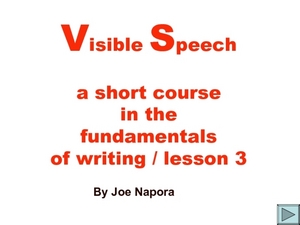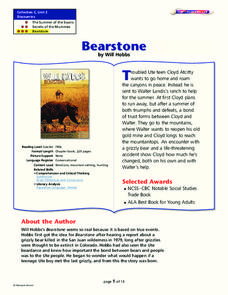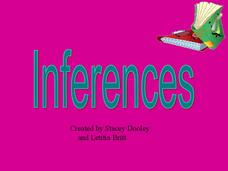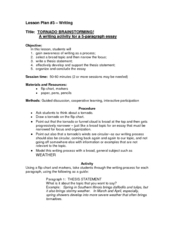Curated OER
Drawing Conclusions
Tenth graders explore why some teenagers take unnecessary risks. In this decision making lesson, 10th graders read an article on risk taking and draw important conclusions on the topic.
Curated OER
Easy Worksheet: Hypothesis and Conclusion 3
In this hypothesis and conclusion worksheet, students solve 6 short answer problems. Students identify the hypothesis or conclusion of a given if-then statement.
Curated OER
Write the Hypothesis and Write the Conclusion Problems
In this logic worksheet, students write the hypothesis for the given statement in two problems and the conclusion in the other two problems. The solutions are not provided.
Curated OER
Around the Room Short Story
Collective story writing is a great way to reinforce the concept of story elements and collaborative learning. Young writers discuss story elements such as, setting, character, action, climax, conclusion, foreshadowing, dialogue, and...
Curated OER
Visible Speech: A Short Course in the Fundamentals of Writing/Lesson 3
Focusing on writing an introduction, this presentation provides a variety of techniques for how to begin. Although the question marks on slide six obscure the writing, the other slides are clear and legible and display good examples for...
Curated OER
Bearstone
Use the story "Bearstone" by Will Hobbs to explore issues related to growing up. In this work, a troubled teen finds himself through an adventure in the wilderness. Learners practice summarizing, drawing inferences and conclusions, and...
Curated OER
Knights of the Round Table adapted by Gwen Ross
Everyone loves the tales involving King Arthur and his knights. After reading Knights of the Round Table by Gwen Gross, learners draw inferences and conclusions, analyze story elements, and discuss figurative language, including...
School Specialty
The Tortoise and the Hare - Drawing Conclusions/Predictions Outcomes
Does the fastest one always win the race? Look deeper into The Tortoise and the Hare with a set of discussion questions for before, during, and after reading the story.
EngageNY
Drawing a Conclusion from an Experiment (part 2)
Communicating results is just as important as getting results! Learners create a poster to highlight their findings in the experiment conducted in the previous lesson in a 30-part series. The resource provides specific criteria and...
Curated OER
Lesson Five: Review Cause and Effect, Draw Conclusions, Compare and Contrast
Third graders review the concepts of compare and contrast, drawing conclusions, and cause and effect. In this literary elements lesson plan, 3rd graders write a paragraph that compares and contrasts the past to the present. They show...
Curated OER
Inferences
Inferences are the focus of this short, but effective resource. Students see that when all of the facts are missing in a piece of writing, one has to make an inference - a guess based on what is known. Students practice by considering...
Curated OER
Tornado Brainstorming
While the focus of this lesson is on writing about tornadoes, any topic could be substituted. The lesson provides a well-thought out overview of the writing process. Learners come up with a thesis statement, supporting details, and a...
Curated OER
Understanding a Story
Reading comprehension is the name of the game! After listening to the teacher model and share personal prior knowledge about small children and what they do with food, the class discusses how they too can use prior knowledge to...
Purdue University
The Great Clearcut Controversy
Urban development and habitat retention are often at odds. A three-part lesson examines the pros and cons of forest clearcutting. Learners review data and characteristics of a specific mammal to make conclusions about the effect...
Roald Dahl
The Twits - The Monkeys Escape
Houses come in all shapes and sizes, but not all houses are safe from Mr. and Mrs. Twit. The 10th lesson in a unit designed to accompany The Twits by Roald Dahl turns learners into architects. While designing houses for the monkeys, they...
Curated OER
Matthew Henson
Discuss the work of Matthew Henson, an African American who traveled to the North Pole with Robert Peary. After reading the story "Matthew Henson" by Maryann N. Weidt, learners answer questions by drawing inferences and conclusions,...
Curated OER
Drawing Conclusions and Comparing/Contrasting - The Everglades
Pupils complete activities to compare, contrast, and draw conclusions for a lesson about the Florida Everglades. In this drawing conclusions lesson, students watch videos about a scientists study of pig frogs that live in the Florida...
Curated OER
Drawing Conclusions: Polka Town, U.S.A.
Students draw conclusions based on a video they watch about towns that thrive on Polka music. In this drawing conclusions lesson plan, students discuss the conclusions with each other based on the implied information they see in the video.
Curated OER
Drawing Conclusions-Miss Navajo
Students practice the higher order thinking skill of drawing conclusions. In this language lesson, students use the Miss Navajo pageant to discuss the role of language in selecting a winner. They view portions of the pageant, and try...
Curated OER
Drawing Conclusions - Is This a Map of the Underground Railroad?
Students complete activities to study potential maps of the Underground Railroad. In this Underground Railroad lesson plan, students watch a video about map collector Anne Zorela's Underground Railroad map. Students complete a graphic...
Curated OER
Lesson 1: Explicit Information versus drawing conclusions
Second graders look at the difference between explicit information and drawing conclusions. In this drawing conclusions lesson, 2nd graders read a passage and find areas where information is given and others where they have to think to...
Curated OER
Explicit Information versus Drawing Conclusions
Fourth graders read a comprehension passage and answer short answer questions and then identify their answers as explicit information or drawing conclusions. In this comprehension lesson plan, 4th graders do this as a whole and individuals.
Curated OER
Speed
Fifth and sixth graders practice working in pairs to determine whether they can walk with constant speed. They test themselves, collect their data, draw graphs with their data collected, manipulate the data, and then draw conclusions...
Curated OER
Paragraph Structure
Practice writing paragraphs with this scaffolded worksheet. The "hamburger" model is used on the second page, following some examples and guided practice on the first page. Give beginning writers concrete, tangible support as they embark...

























